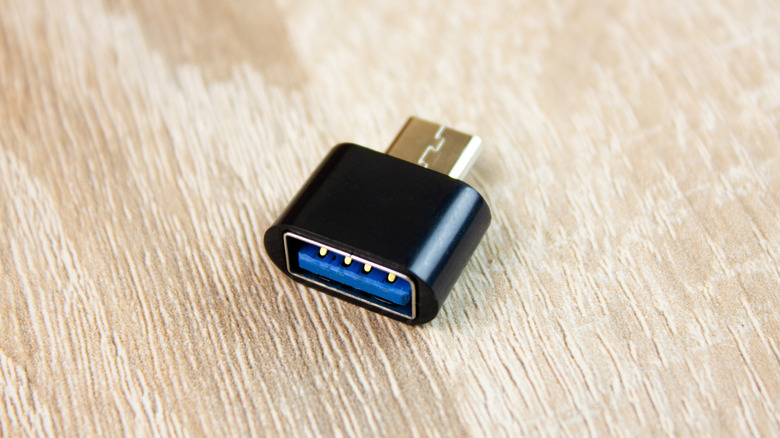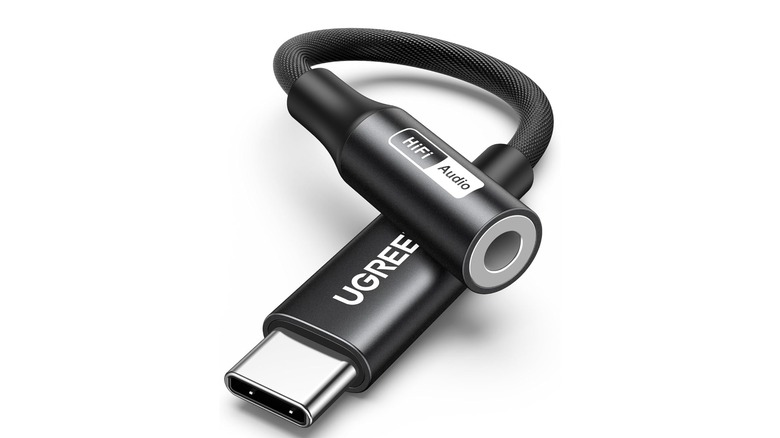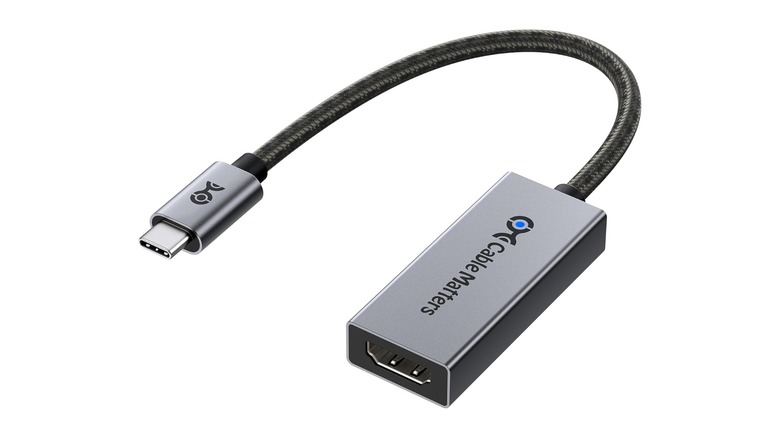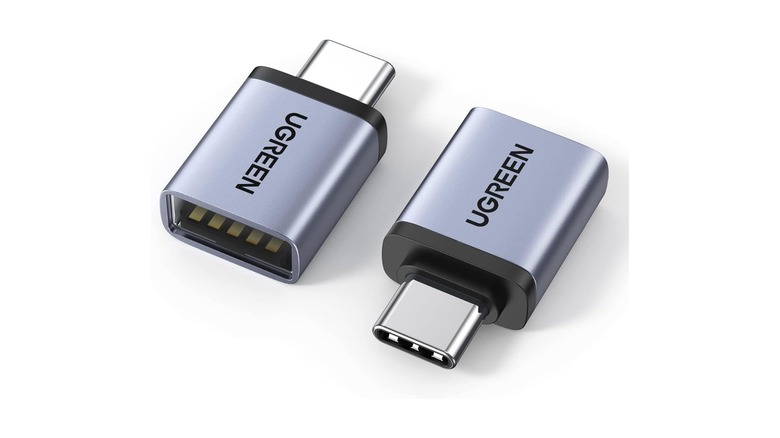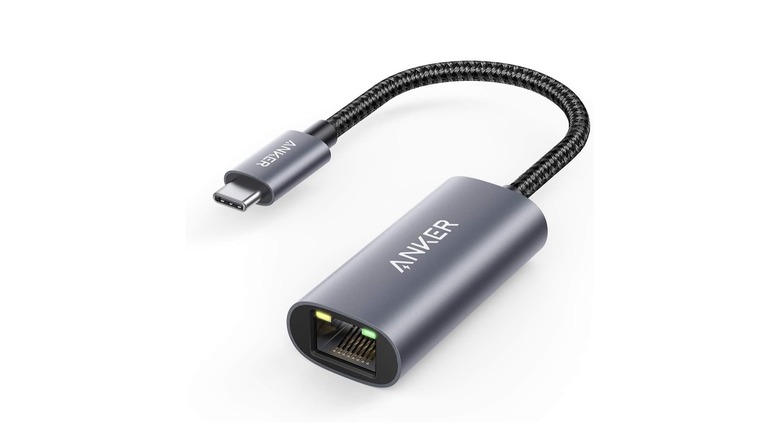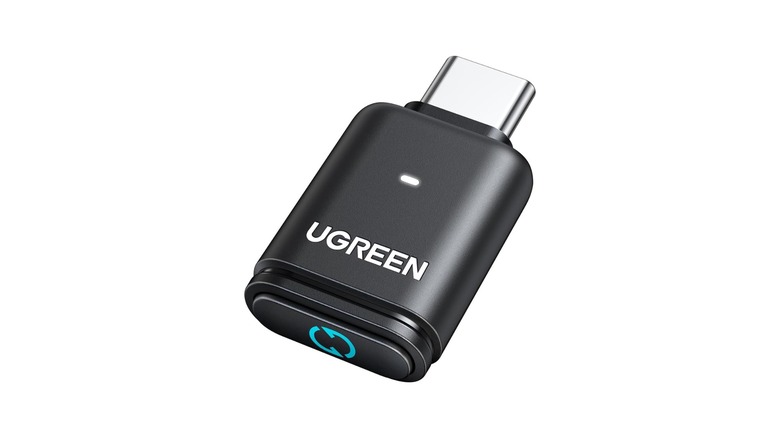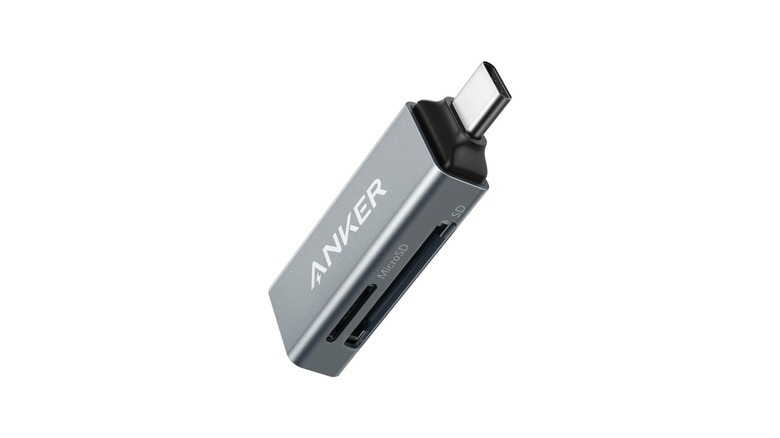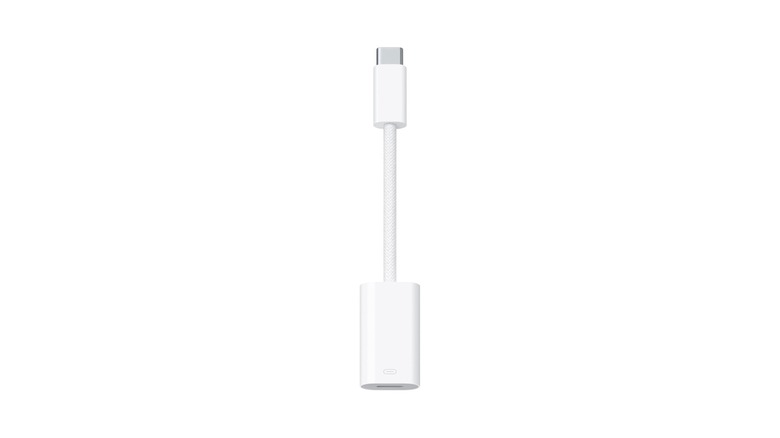7 Types Of USB-C Adapters (And What To Use Them For)
The USB-C connector has seen mass adoption over the past decade, and is now found on nearly every device from expensive phones and laptops to cheap gas store gadgets. When it launched, USB-C promised to be a miracle port that combined all the functionality of charging, data transfer, video output, Ethernet and more into a single, tiny plug. Over a decade later, the connection standard has lived up to its hype in some ways, but in others, USB-C has become a confusing mess. Rarely is any USB-C port or cable a one-stop shop for every kind of connection the standard supposedly supports. Instead, those devoted to the USB-C life often find themselves toting around a spider's nest of adapters. There are adapters for headphones, displays, chargers and more.
Given the wide variety of uses for USB-C and the Cambrian explosion of adapters that has ensued, let's break down six of the most common adapters you'll find on offer. In addition to covering what each adapter is for, we'll also take a look at how to choose the right ones to make sure you don't need to replace them well into the future. So, here are six types of USB-C adapters that can help you get your gadgets connected and keep your computer convenient.
USB-C to 3.5mm audio adapter
Since the iPhone 7 did away with the device's headphone jack, the USB-C to 3.5mm adapter has been necessary for anyone who wants to use wired headphones on the go. Given that some wired headphones can produce much higher quality sound than Bluetooth headphones, this has been particularly frustrating for audiophiles and music enthusiasts, who must now carry around extra hardware. However, it does give wired headphones users the opportunity to choose their own digital audio converter (DAC), which is the part of the dongle that converts the digital audio signal to an analog one that headphones can use to output sound.
If you own fancy headphones, you'll want to make sure you get a 3.5mm dongle that supports high resolution audio, such as this UGREEN USB-C to 3.5mm Audio Adapter that supports 32-bit audio at up to 384 kilohertz. If you're not sure whether your headphones are fancy, you'll probably be just fine with something like the Anker USB-C to 3.5mm Audio Adapter that supports 24-bit audio at up to 96 kHz, which is a superb listening experience for most people. Of course, you'll need to have audio files of that quality to maximize the experience.
You're probably most familiar with the USB-C to female 3.5mm adapter, which gives you a slot for connecting the male plug on your headphones. But you can also get something like this JMOX USB-C to 3.5mm Audio Aux Jack Cable, which ends in the protruding, male connector. This is designed for plugging directly into your car's auxillery 3.5mm port, obviating the need for a 3.5mm male to male extension cable (colloquially known as an aux cord).
USB-C to HDMI or DisplayPort
One of USB-C's many capabilities includes video output via HDMI and/or DisplayPort. Many computers, phones, and tablets can output video from their USB-C port, but the problem is that most displays, such as monitors and TVs, don't have a USB-C input. That means you either need a dongle to convert your output device's USB port into an HDMI or DisplayPort port, or a cable with a male USB-C connector on one end and a male video connector on the other
When shopping for a USB-C to HDMI or DisplayPort connector, it's important to pay close attention to the specs. If you're looking for HDMI, you'll be most future-proofed with a dongle that supports HDMI 2.1 and is able to output 4K video at 144 hertz. For DisplayPort, seek out DisplayPort 2.1, which can support even more impressive specs, outputting 4K video at 240 hertz. Even if you don't currently own a monitor or TV with those specs, you'll never need to worry about your dongle being the bottleneck when connecting to a wired display. And if you do upgrade, you won't need a new dongle.
If you need to store the dongle, you're probably best off with a male USB-C to female HDMI or DisplayPort adapter such as this Cable Matters USB-C to HDMI 2.1 Adapter. However, if the cable won't be travelling much (for example, if it will always be connected to your desktop monitor) you should get a longer, male USB-C to male HDMI or DisplayPort cable such as this UGREEN USB-C to DisplayPort 2.1 Cable. I happen to own this particular cable and it's been perfect for connecting laptops and tablets to my gaming monitor.
USB-C to USB Type-A
Whether you're dealing with a webcam or a flash drive, plenty of peripherals are still made with the older Type-A connector. Meanwhile, many laptops, including the MacBook Air and Microsoft Surface Pro, have done away with the Type-A port. Sometimes you find yourself with a USB accessory that uses a Type-A connector (the older, rectangular kind of USB port) and nothing but a USB-C port to plug it into. That's why a USB-C to USB-A adapter can be essential to have on hand.
USB standards are a bit convoluted, but since newer versions of USB are backwards compatible with older versions, there's no downside to getting an adapter that supports a newer USB version. For example, this UGREEN USB to USB-C Adapter supports USB 3.2 Gen 2, which has a throughput of 10 gigabits per-second. It's not the newest version of USB, but you won't find too many devices on the market yet that are equipped with the latest USB 4.0 speeds. For basic peripherals like mice, keyboards, and webcams, this adapter is still overkill, and it matches the most common specs for the latest storage devices such as flash drives. Of course, you may also need an adapter that goes the other way around, converting a USB Type-A port into a Type-C port. These Syntech USB-C to USB adapters work well.
USB-C to Ethernet
One capability of USB-C that's less frequently discussed is its ability to carry a wired Ethernet signal. Using a wired internet connection instead of Wi-Fi can be more stable, and it will usually carry lower latency. For tasks like online gaming or downloading large files, the ability to use an Ethernet connection is still useful. However, many laptops hide their Ethernet capabilities inside of a USB-C port, so if all you've got is an Ethernet cable, you'll need an adapter.
For most people in North America, an adapter capable of carrying a 1 gigabit connection will more than suffice. This Anker USB-C to Ethernet Adapter is one such example. If you know your internet connection is capable of higher speeds, which are offered in select areas by certain ISPs, look into an adapter like this UGREEN USB-C to Ethernet Adapter, which supports speeds up to 2.5 gigabits per-second. If you'd rather cut out the adapter middleman, you can simply buy a male-to-male USB-C to Ethernet cable. For example, if you're connecting your laptop to Ethernet in your office each day, a cable may be a better choice than an adapter.
USB-C to Bluetooth
So far, we've discussed adapters that convert USB-C to another wired standard, but what about wireless adapters? For instance, what if you've got a computer or phone with a broken Bluetooth radio, but you still need to connect it to Bluetooth devices? Or, what if you want to connect Bluetooth headphones to a PlayStation 5, Nintendo Switch, or a TV? In that case, you should consider a USB-C to Bluetooth adapter.
Simply put, a USB-C to Bluetooth dongle or adapter basically attaches a Bluetooth radio to a USB-C equipped device, allowing you to connect Bluetooth devices such as headphones, mice, keyboards, and more. It can be especially useful for adding Bluetooth to a device that lacks it. For example, the PS5 does not include Bluetooth, but it does include USB-C ports, meaning you can plug a Bluetooth adapter in if you want to use your existing AirPods or other Bluetooth audio device while gaming. A Bluetooth adapter can also be a great solution for adding Bluetooth to an older computer that doesn't come with the wireless technology.
USB-C to SD or MicroSD
For photographers on the go, or those who still have expandable storage on their phones, an SD card reader is a necessity. The super compact storage devices are among the most convenient forms of portable flash media on the planet, as they're incredibly thin, light, and easy to store. The latest version of SD technology can handle up to a staggering 128 terabytes on a single SD card. You won't find That's what makes them perfect for devices like high end cameras, where each shot can be incredibly information dense, and for mobile storage, allowing users to add more storage capacity when their phone runs out of space. But there's a growing problem. Fewer and fewer devices come with SD readers, meaning you'll need a USB-C to SD or MicroSD card reader adapter.
Luckily, USB-C to SD card adapters are inexpensive. You're best off with an adapter that can read both regular SD and the smaller MicroSD type cards, since both are still relatively common. For instance, this Anker SD Card Reader has two different slots for both types of cards, and it works with almost any computer, phone, or tablet that has a USB-C port. But what if your phone doesn't have an SD card reader and you want to shoot high-quality videos or photos on the go? The latest smartphones from Apple and Samsung can shoot video in the high quality Log format and save the videos to an attached storage device so as not to fill your phone's storage up. For that, you might want the Anker MagGo USB-C to SD Card Reader Adapter, which tucks the reader away on the back of your phone.
USB-C to Lightning
If you've got an iPhone 15 or newer, your phone has a USB-C port (although depending on which model you have, your iPhone's USB-C isn't up to date). That's good news in general, since it's a more modern connector than the Lightning port it replaced. That port was growing stale after first debuting on the iPhone 5 over a decade ago, but if you still have a massive trove of Lightning accessories that are now incompatible with your smartphone, that's a big disappointment. Luckily, you can probably still get most of your Lightning accessories to work with your USB-C iPhone using a USB-C to Lightning adapter. Some Lightning accessories may even work on USB-C equipped Android devices via a Lightning adapter, giving team green users access to a much greater variety of choice.
Apple sells its own USB-C to Lightning Adapter, but it's a bit overpriced at $30. The short cable is braided, and the adapter handles charging, data, and audio. That means you'll have all your bases covered, which is nice, but you can get the same functionality from this UWOXX USB-C to Lightning Female Adapter for just over a third of the price. Using one of those, or a similar adapter, you should be able to connect Lightning chargers, audio devices, or other accessories made for older iPhones.
